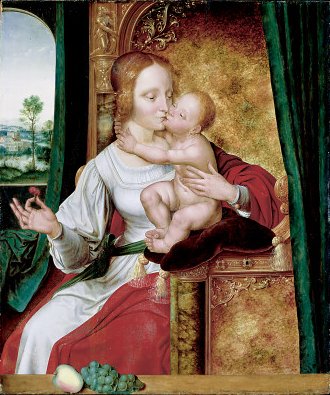 |
|
Madonna of the Cherries
Quentin Massys & Workshop, Early Netherlandish 1465-1530
SN 200, Panel. Painted in 1520's
by Robert Anderson. 2000
Artist:
Quienten Massys was a leading painter of early 16th century Antwerp. He was said to have
been self-taught although he may have been trained as a miniaturist and by Hans Memling in
Brugge who may well have been a source for his style. Massys' activity as a portrait
painter specialized in images of wealthy, rather than noble, clients and his international
renown was comparable to Memling's own sucess in these areas.
His first major religious work was painted when he was 41 (c.1508) and was
a large altarpiece painted for the confraternity of St. Anne. His masterwork, the enormous
St. John altarpiece was painted for the chapel of the Joiners Guild in Antwerp Cathedral
at approximately the same time.
Massys celebrated native South Netherlandish traditions, reflecting both
Hugo van der Goes diptych's and the modernizing & refining images from Jan van Eyck's
Ghent Altarpiece. Other striking features of Massys' work were his Italianate lighting and
ornament as well as a sfumato ala |
Leonardo da Vinci which softened and modified his colors.This dual
interest of Massys reflected the taste of the ruling Habsburg Regent of the
Netherlands.Two of Massys' best known secular works are Money Changer and His Wife, and
the portrait of Erasmus of Rotterdam. in which those portrayed have fully developed
personalities and show distinct moods.
By the 1520's Massys was painting portraits and small panels for private
use. These included both portraiture as well as religious and secular subject matter. In
these later paintings Massys style became increasingly Italianate with landscape
backgrounds reminiscent of Raphael. His work became more mature and complicated and a life
sized work of the Virgin and Child Enthroned served as an altarpiece in Archduchess
Isabella's Palace in Brussels - an indication of the esteem in which Massys was held in
Rubens' day.
Subject:
The painting which probably served as an altarpiece, either in a church chapel or in a
private home shows the Madonna and Child seated on an imposing architectural throne of
carved and gilded marble.
Painting:
The scene of the Madonna and Child is one of warm affectionate intimacy. The mother and
child are seen kissing one another in an altogether human and realistic relationship. The
Madonna, dressed in a red robe and white gown, is seen holding two cherries in the fingers
of her right hand while the Christ Child sits on a purple pillow which could reflect
royalty. The couple are positioned behind a ledge on which are an apple and some grapes.
In the background at the left there is a view of a river valley.
The apple is symbolic of the fall of man ( original sin = Adam eating the
apple) while the grapes represent salvation ( wine of redemption = The Eucharist). The
cherries were known symbolically as the fruit of Heaven and would indicate that the
Madonna and Christ Child are in heaven - exempt from all sin.
Historical Context:
This painting is one of three copies of the same subject painted by the artist. It is our
opinion that the Ringling painting is the origional. One of the other versions of this
composition hangs in the Rijksmuseum, Amsterdam.
The painting shows the influence of Raphael ( background landscape).
Massys in turn influenced the artistic development of both the Carracci and Rubens.
ringlingdocents.org
|
